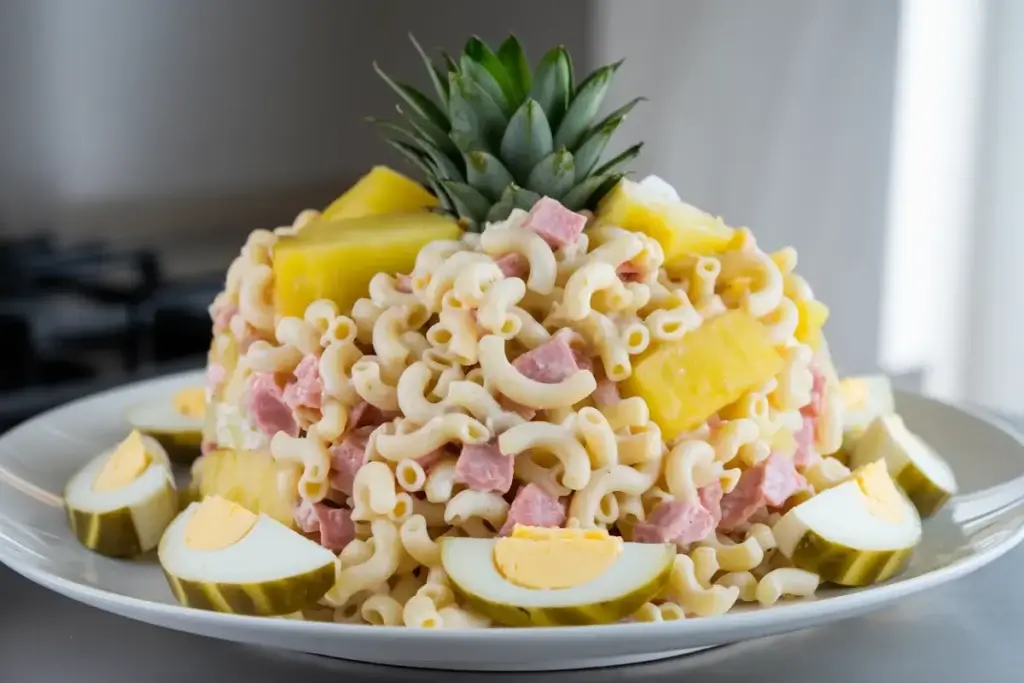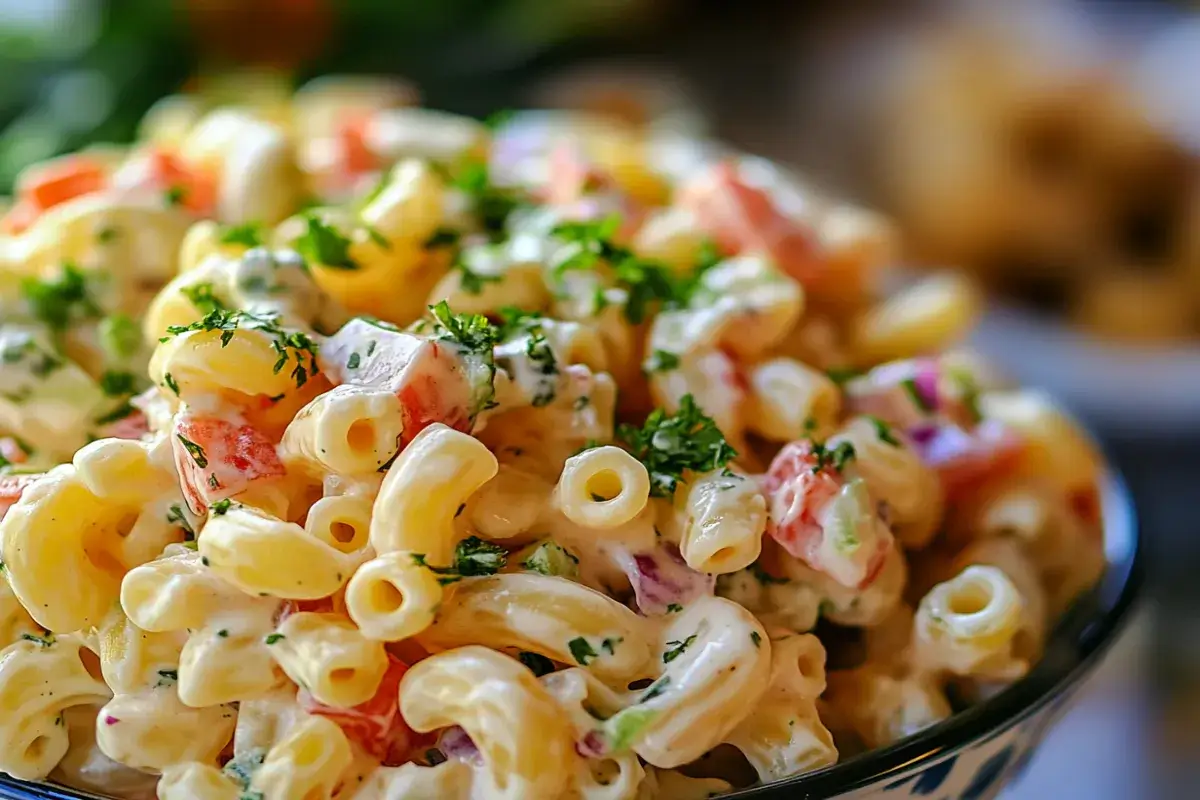Part 1: Introduction
Hawaiian Macaroni Salad—just the name conjures up images of a tropical paradise. Imagine yourself lounging by the beach, the sun warming your skin, and a plate of this creamy, tangy delight in front of you. This isn’t just any side dish; it’s a staple of Hawaiian cuisine, a must-have at any BBQ, Luau, or casual get-together. But why has this humble dish, which is simply macaroni dressed in mayo with a few extras, gained such popularity? Well, that’s what we’re about to dive into. By the end of this article, not only will you know how to whip up an authentic Hawaiian Macaroni Salad at home, but you’ll also understand its rich history and cultural significance. So, let’s get started on this flavorful journey!
Part 2: History and Cultural Significance
The Origins of Hawaiian Macaroni Salad
You might wonder, how did macaroni salad—something that seems so American—become a cornerstone of Hawaiian cuisine? The story begins with the introduction of Western ingredients to the Hawaiian Islands during the 19th and 20th centuries. Macaroni, like many other foods, was brought over by European settlers and eventually found its way into local diets. Hawaiian cooks, known for their adaptability, took these new ingredients and made them their own.
By the mid-20th century, plate lunches—a typical Hawaiian meal featuring a protein, rice, and macaroni salad—had become a common sight across the islands. Macaroni salad was cheap, easy to make, and could be prepared in large quantities, making it perfect for feeding hungry workers. Over time, this simple dish became ingrained in the Hawaiian culinary landscape.
Cultural Importance in Hawaii
Today, Hawaiian Macaroni Salad is more than just a side dish. It’s a symbol of comfort and tradition, often served at family gatherings, barbecues, and local restaurants. Its creamy texture and mild flavor make it the perfect counterbalance to the bold, savory dishes typically found in Hawaiian cuisine, such as Kalua pork or Huli-Huli chicken. The salad’s simplicity is what makes it so beloved. When you’re enjoying a scoop of it alongside your plate lunch, you’re not just eating food—you’re partaking in a bit of Hawaiian culture.
Part 3: Ingredients Overview
Essential Ingredients for Authentic Hawaiian Macaroni Salad
Now that we’ve covered the history, let’s talk ingredients. To make a truly authentic Hawaiian Macaroni Salad, you’ll need to get a few things right. Here’s what you’ll need:
- Macaroni: The foundation of the dish. Use elbow macaroni cooked just right—firm but tender. It should hold up to the dressing without turning mushy.
- Mayonnaise: This is the heart of the salad. But not just any mayo will do! You must use Best Foods or Hellman’s. These brands are known for their rich, creamy consistency that’s essential for achieving the correct texture. Trust us, no other mayo will give you the same result.
- Apple Cider Vinegar: A splash of this adds a subtle tang that brightens the whole dish.
- Carrots and Onions: Finely shredded carrots and optional onions add a bit of crunch and sweetness, balancing out the creamy mayo.
- Milk and Sugar: The milk helps to thin the mayo just a bit, making the dressing smooth and luxurious. A teaspoon or two of sugar adds a gentle sweetness that plays perfectly with the other flavors.
- Salt and Pepper: Finally, season with kosher salt and freshly ground black pepper to taste. Don’t skip these—they’re key to bringing all the flavors together.
By sticking to these ingredients, you’ll stay true to the traditional recipe, which is all about simplicity and balance.
Part 4: Step-by-Step Recipe Guide
How to Make Hawaiian Macaroni Salad
Making Hawaiian Macaroni Salad might seem straightforward, but there are a few tricks to getting it just right. Follow these steps, and you’ll be serving up a dish that’s creamy, tangy, and utterly irresistible.
- Preparation of Macaroni: Start by cooking 1 pound of elbow macaroni according to the package directions. You want the pasta to be al dente—firm but cooked through. After cooking, immediately rinse the macaroni under cold water to stop the cooking process and cool it down. Let it drain thoroughly.
- Mixing the Ingredients: While the macaroni is draining, shred 2 medium-sized carrots and, if you like, ¼ cup of onion. In a large bowl, combine the cooled macaroni, shredded carrots, and onion. Drizzle 2 tablespoons of apple cider vinegar over the mixture and toss to combine. This vinegar adds a nice tangy note that really makes the dish pop.
- Making the Dressing: In a separate bowl, whisk together 2½ cups of mayonnaise, ¼ cup of milk, and 2 teaspoons of sugar. This creates a creamy dressing that clings to the macaroni without being too heavy.
- Final Assembly: Pour the dressing over the macaroni mixture and gently fold everything together until the noodles are evenly coated. Be careful not to overmix—you don’t want to break up the macaroni. Season with salt and pepper to taste. Cover the bowl with plastic wrap and refrigerate for at least 4 hours, though overnight is best. This chilling time allows the flavors to meld and the salad to firm up.
- Chilling and Serving Tips: Before serving, give the salad a gentle stir. If it seems a bit dry, add a splash of milk to loosen it up—just a tablespoon or two should do the trick. Serve chilled, alongside your favorite BBQ dishes or as part of a traditional plate lunch.
Part 5: Variations and Substitutions
Healthy and Vegan Variations
Not everyone is a fan of the rich, mayo-heavy dressing traditionally used in Hawaiian Macaroni Salad. Luckily, there are plenty of ways to lighten it up or make it suitable for different diets without sacrificing flavor.
- Reducing Mayo: If you’re looking to cut down on the mayo, try substituting half of it with Greek yogurt. This gives the salad a slight tang while keeping it creamy. However, keep in mind that the flavor and texture won’t be exactly the same as the original.
- Vegan Adaptations: For a vegan version, replace the regular mayo with vegan mayonnaise. Hellman’s makes a great vegan option that’s just as creamy as the original. You can also swap the milk for unsweetened cashew milk or any other non-dairy milk. These changes make the salad vegan-friendly without compromising on that classic taste.
- Gluten-Free Version: If you’re gluten intolerant, no worries! Just substitute the regular elbow macaroni with a gluten-free version. Be sure to cook the pasta according to the package instructions, as gluten-free pasta can sometimes cook differently than regular pasta.
For more creative salad options, you might want to try this Street Corn Pasta Salad, which offers a unique twist on the traditional pasta salad concept.
These variations ensure that everyone can enjoy this delicious dish, regardless of dietary restrictions.
Part 6: Common Mistakes to Avoid
Tips and Tricks for Perfect Hawaiian Macaroni Salad
Even a simple dish like Hawaiian Macaroni Salad has its pitfalls. To make sure your salad turns out just right, here are some common mistakes to avoid:
- Rinsing the Macaroni: There’s a bit of debate on whether you should rinse the macaroni after cooking. In this case, rinsing is recommended because it stops the cooking process and cools the pasta quickly, preventing it from becoming too soft. Plus, it helps the dressing coat the pasta evenly.
- Overmixing: When mixing the salad, it’s easy to get carried away. But overmixing can break up the macaroni, leading to a mushy texture. To avoid this, gently fold the ingredients together using a large spatula.
- Correct Consistency: After the salad has chilled, it may seem a little dry. This happens because the pasta absorbs some of the dressing. To fix this, stir in a bit more milk just before serving to restore the creamy consistency.
By keeping these tips in mind, you’ll avoid common pitfalls and ensure your salad is as delicious as possible.

Part 7: FAQs
Frequently Asked Questions about Hawaiian Macaroni Salad
We all have questions when trying out a new recipe, and Hawaiian Macaroni Salad is no exception. Here are some of the most frequently asked questions:
- What makes Hawaiian macaroni salad different?
Hawaiian macaroni salad is unique because of its simplicity and the use of specific ingredients like Best Foods or Hellman’s mayo, which give it its signature creamy texture. - Can I use other types of pasta?
While elbow macaroni is traditional, you can use other small pasta shapes like shells or ditalini. However, the texture might be slightly different. - How long can I store Hawaiian macaroni salad?
This salad can be stored in an airtight container in the fridge for up to 3-4 days. If it starts to dry out, just add a splash of milk before serving. - Is it okay to add other ingredients like ham or pineapple?
Traditional Hawaiian macaroni salad is kept simple, without added ingredients like ham or pineapple. Adding these might stray from the classic recipe, but feel free to experiment if you like! - What can I substitute if I don’t have apple cider vinegar?
If you’re out of apple cider vinegar, you can use white vinegar or even lemon juice. These alternatives will still provide that needed tang.
These FAQs cover some of the most common concerns and will help ensure your Hawaiian Macaroni Salad turns out perfectly every time.
Part 8: Conclusion
So, why should you make Hawaiian Macaroni Salad at home? Simply put, it’s a dish that brings a little bit of Hawaii to your table. Its creamy, tangy flavor pairs beautifully with almost any main dish, and it’s sure to be a hit whether you’re serving it at a BBQ, a Luau, or just as a side for a family dinner. Plus, it’s easy to make and can be adapted to suit different dietary needs. So, what are you waiting for? Grab your ingredients, and let’s bring a taste of the islands to your kitchen!
For more on Hawaiian cuisine, you can check out this article on Wikipedia about the traditional foods of Hawaii. Additionally, if you want to explore how the plate lunch concept originated, Wikipedia provides an excellent resource on the topic.
